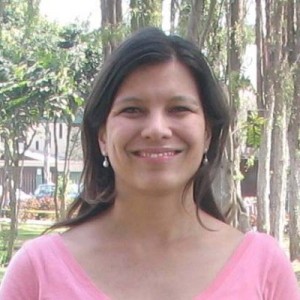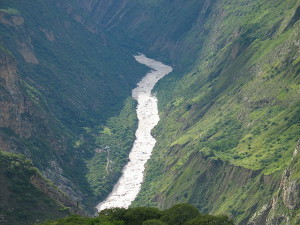This is an interview with Sarah-Lan Mathez-Stiefel, Postdoctoral Fellow at World Agroforestry Centre, about her research project in the Apurimac region of the Peruvian Andes.
- In your own words, what is this project about?
 The objective of the whole study is to come up with recommendations for the use of agroforestry as a strategy to face climate change. More specifically, the project is about understanding how men and women benefit from agroforestry species and practices in the Andes of Peru. I am looking not only at the economic benefits but also ecological, social, and cultural.
The objective of the whole study is to come up with recommendations for the use of agroforestry as a strategy to face climate change. More specifically, the project is about understanding how men and women benefit from agroforestry species and practices in the Andes of Peru. I am looking not only at the economic benefits but also ecological, social, and cultural.
I am also looking at local knowledge on agroforestry practices and species and how this knowledge differs according to gender, age, and other aspects such as where they live –(i.e. at which elevation belt).
I am working with indigenous Quechua-speaking communities in the southern Peruvian Andes, and I am working in the micro watershed of Apurimac, which extends from 1,800 to 4,300 meters above sea level.
- What can this project achieve?
Up to now, ICRAF in Peru and in South America has been working mainly in the lowlands in the Amazon. Last year with this project, we started working in the highlands, the Andes, which is a totally different context. So from the perspective of ICRAF, we are starting from scratch. This region has seen agroforestry development projects in the past, but reports are difficult to find and there has been little published research on agroforestry.
This is the reason why we are first doing an assessment of the local knowledge, the local practices, and local perceptions on species and practices. The idea is also to identify the gaps in research that can inform future projects.
It is also important to mention that we are doing this in collaboration with the Andean Forests Programme on Climate Change, which is financed by the Swiss Agency for Development and Cooperation. Apurimac is one of their implementation sites, where they have plans to do follow-up development activities and policy support. We are thus providing important insights from our research for this programme. This is very important because they can directly implement our recommendations.
- How has this project emerged from previous research?
This is a new geographic context for ICRAF, but in order to design the research methodology I drew on tools and approaches that ICRAF is using in other parts of the world, such as the Agroecological Knowledge Toolkit, that Fergus Sinclair [Leader of ICRAF’s research on agroforestry systems] has been developing with Bangor University, and also some other tools that Meine Van Noordwijk [ICRAF’s Chief Science Advisor] has been using, such as Rapid Agroforestry Assessments. I am combining these tools with my own personal experience with transdisciplinary approaches. I’ve been working for the last ten years in the Andes with the Centre for Development and Environment of the University of Bern, which has developed a lot of trans-disciplinary tools, which means both interdisciplinary and participatory (i.e. including non-scientific actors in the research process). So I combined my own experience, knowledge of the context, and methodologies with ICRAF tools that have been successfully applied in other parts of the world.
- You’ve done a lot of work with indigenous communities. We would like to ask you about the complexities associated with conducting cross-cultural research, especially when studying complex and often context-specific gender norms. Have any such challenges emerged during this project? If so, how have you dealt with them?

In my case it was easier because I already knew well the context, as I did my PhD research with indigenous communities in the Andes. My recommendation is that you really need someone who can explain the culturally appropriate ways to contact local communities and engage in the research process. More specifically in the Andes, this means that you need to contact the local leaders and ask permission to participate in a community assembly. All of the site’s inhabitants attend this meeting, and it is there that you can introduce yourself, explain the research objectives, ask for their authorization and their interest in having this research in their community, and finally discuss how the process will be carried out, what the products will be, and whether there are specific products or outcomes that they would like to get from the research. This is a fundamental step before starting any research in an Andean community.
And regarding gender, this is a bit trickier because traditionally women don’t participate much in community decision-making. It’s very difficult to involve them; you really need to insist on having workshops or focus groups specifically with women and to explain clearly the reasons for that to local leaders. So it is feasible, but you really need to make an extra effort to have women participate. A number of reasons limit their participation. On the one hand, women have very limited time. They are overloaded with work; they work much more than men in the field, so it’s difficult for them to take a few hours out of their daily activities. On the other hand, they often have less education, they are shy, or they refuse to speak in public, so it’s not so easy to motivate them to come and participate in this type of community meeting. But it is feasible with patience.
I speak a little bit of Quechua and understand a bit, but I always work with local interpreters. This is also very important for the research process. Local people who went to school speak Spanish but they still feel more comfortable speaking in Quechua, and especially if you are researching local knowledge and local perceptions, it is really important to work in the local language. And this is even more the case when you work with women, because their Spanish is usually not very good. So I usually work with young people from the community who speak Spanish well whom I train, and I co-facilitate the discussions with them.
- What other challenges have you faced in the project, and how have you addressed them?
Other challenges are that it is important to respect the time of the communities and the local participants. So sometimes things don’t go according to your plan or to your research schedule because suddenly there can be other priorities for the community(e.g. the inauguration of a health post or heavy rains that mean the harvest has to be postponed). So you really need to be very flexible, because this also means that it takes more time to do this type of participatory research.
Another challenge is that – even though you may have received authorization from the assembly and developed a good relation with the leaders – things can always change. If that happens, you need to restart the dialogue, and you often have to reach agreements again on what the research is about and what the results will be for the community.
- What is your background? How did you get to be where you are today?
I studied cultural anthropology and biology in Switzerland, in parallel, because I was always fascinated by the relationship between people, culture, and nature. I did the equivalent of masters in ethnobotany and then I went on to work for the Centre for Development and Environment at the University of Bern, where I still hold a part-time position. This is an interdisciplinary Centre that works on research for development in developing countries, designing tools, methodologies, capacity building, etc.
It was a very interesting experience. There, I was the coordinator of their Eastern and Southern Africa partnership programme, which was a programme of small-to-medium grants working with local partners on sustainable development and natural resource management projects. This was a very enriching experience for me at a relatively young age because, not only was I involved in very diverse and interdisciplinary projects, but I also learned to work in partnership with very different actors in developing countries – NGOs, universities, international organisations, etc.
I started working with trans-disciplinary tools that help you bridge between disciplines and also between science and society. More specifically, I worked a lot with social learning tools where you facilitate multi-stakeholder learning processes and knowledge co-production.
It was also with the Centre for Development and Environment that I came to the Andean region in the beginning of 2006 to work as an advisor for a Swiss-funded programme called BioAndes and to carry out research for my PhD in the framework of that programme. My PhD was on the dynamics of traditional medicinal knowledge. I worked for the programme from 2006 to 2011.
As of 2010, I also assumed the leadership of A Rocha Peru, a Peruvian non-for profit conservation organization. We did a lot of reforestation with native trees along the Peruvian coast, combined with environmental education and other activities that involved local communities.
My experience has always been bridging between academia and implementation and practice, so when the possibility to work with ICRAF came up I was delighted as it was exactly what I wanted to do, which is to work on research in development together with local actors.
- Given that this is the newsletter for the CGIAR research programme on forests, trees and agroforestry, it is important to our readers to know: if you were a tree, which tree would you be, and why?
I would choose the “Sauco” or Peruvian elderberry (Sambucus peruviana), because it represents my research work in Andes, at the intersection between nature and culture, and between tradition and change. It is a native tree, but it is often planted by water springs and along rivers, as it is believed to conserve the water. It was and still is traditionally used as a medicinal plant, especially against “bad wind” and other culture-bound illnesses. A recent innovation in Andean communities has been to prepare jams out of its fruits and commercialize them in local urban centres.











